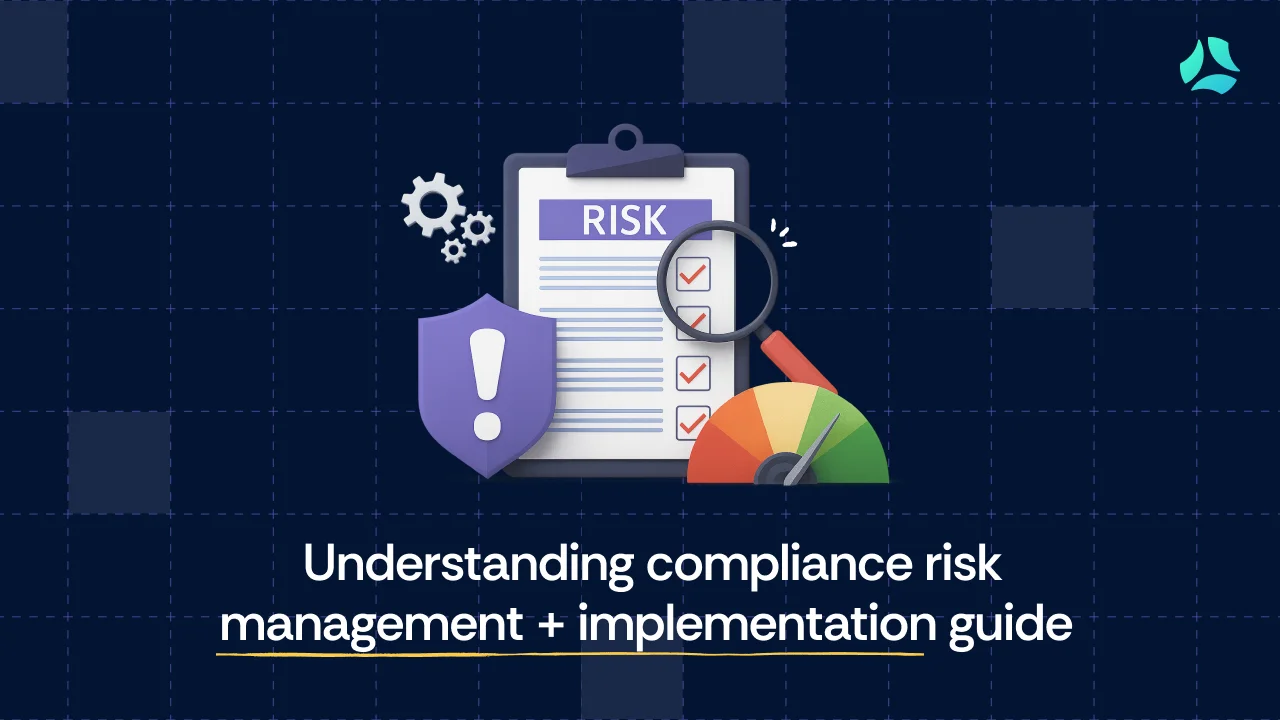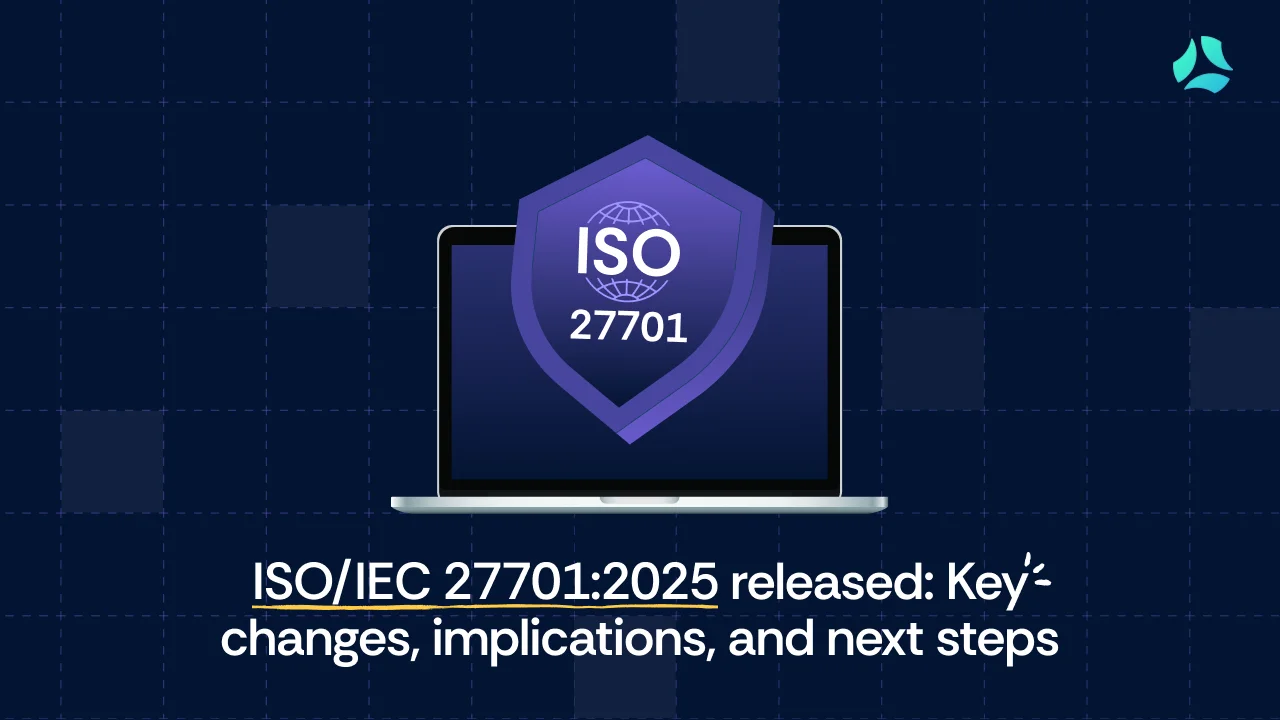Compliance risk management: 5 best practices for 2025

From GDPR to HIPAA to CCPA and anti-money laundering law (AML), the regulatory landscape is getting more complex. A global compliance survey found that 90% of executives see compliance as more complex than it was three years ago.
The takeaway? Compliance risk management is no longer optional. It's critical for earning investor trust, closing enterprise deals, and avoiding costly fines or reputational damage.
Fortunately, compliance risk management automation speeds up the process efficiently. Automating risk management can help you stay continuously audit-ready, scale faster, and build credibility with customers, investors, and partners.
In this blog, we’ll help you understand what compliance risk management really means, why it is essential in 2025, and how to implement it effectively—with five best practices you can apply today.
What is compliance risk management?
Compliance risk management is about scaling your business while playing by the rules. Think of it as identifying, evaluating, and mitigating financial, data security, legal, and reputational risks arising from not following applicable laws, industry standards, regional regulations, or even your own company policies.
Effective compliance risk management is about being proactive. You figure out where your business could unintentionally break rules—these are your compliance risks. Then, you take further action by setting up controls to prevent such slip-ups or minimize damage to your operations, finances, or reputation.
Here’s what effective compliance risk management involves:
- Risk identification: Pinpoint the laws, regulations, and internal policies that apply to your business and where you’re most likely to fall short.
- Risk profiling: Assess the likelihood and potential impact (financial, legal, reputational, operational) of each compliance risk. This allows you to categorize them by severity and prioritize your mitigation efforts accordingly.
- Policies and controls: The actual safeguards, documented policies, and established controls designed to prevent or detect compliance failures.
- Awareness and training: Train your teams with the essential knowledge and guidance to meet compliance responsibilities and act with integrity.
- Testing and monitoring: Assess mechanisms like continuous monitoring and internal audits to regularly test controls and review policies. Are they working? Are they up to date?
- Response and remediation: Build predefined protocols to address compliance failures with detailed analysis, corrective actions, and policy and control adjustments.
- Leadership oversight: Ensure active involvement, guidance, and support from the C-suite to prioritize compliance across the organization.
Why compliance risk management matters for modern startups and SMEs
Startups and SMEs often operate with limited resources and aggressive growth targets. In this environment, compliance can feel secondary, but ignoring it can lead to serious consequences, including delayed funding rounds, failed vendor risk assessments, and an inability to sell in regulated markets.
Many fast-growing companies delay investing in compliance, assuming it can be handled later. What they fail to realize is that most investors don’t regard compliance as an option; it’s one of their critical checkpoints during due diligence.
According to a 2023 Annual Litigation Trends survey, regulation and inspection issues were among the top three types of litigation, with 48% of firms reporting experiencing such litigation and 41% calling it one of the most troubling legal issues.
A strong compliance risk management program helps businesses avoid these pitfalls. It also enables smoother market entry, strengthens enterprise deal pipelines, and builds credibility with investors, customers, and partners.
Common compliance risks (examples by industry)
While all companies face compliance risks, the most critical threats vary by industry. Here are some examples of risk-heavy domains and the regulations that drive them:
SaaS and digital tech providers
The primary compliance risks in this sector include data privacy, cybersecurity, and third-party vulnerabilities. These companies can mitigate these risks by aligning their security practices with laws like GDPR and CCPA. They must also manage the risk of security breaches by adhering to standards like SOC 2 and ISO 27001. Failure to manage these risks can lead to massive fines and lost customer trust. For example, in 2023, Meta (formerly Facebook) was fined €1.2 billion—the largest GDPR fine to date—for transferring EU user data to the U.S. without adequate protection mechanisms.
Banking and fintech
Organizations in this domain face immense risk from financial crimes, inaccurate disclosures, and data breaches, leading to stringent regulatory requirements. They should prevent illicit activities like money laundering through strict AML and Know Your Customer (KYC) regulations. Failure to do this can lead to severe penalties from bodies like the SEC (US) or FCA (UK). They must also protect sensitive financial data through frameworks like SOC 2 and compliance with data protection laws like the GDPR.
Healthcare
Another highly regulated industry, healthtech is dominated by risks of compromising patient data, relying on non-compliant processors, and violating clinical standards. By strictly following regulatory laws like HIPAA and HITECH, healthcare organizations can mitigate the risk of exposing patient health information (PHI). Non-compliance can result in financial penalties, lawsuits, criminal charges, license revocation, and loss of patient trust.
Compliance risk management process
Implementing a structured compliance risk management program helps you proactively unearth and mitigate compliance risks—before they become costly problems.
Here’s how to get started:
Step 1. Identify compliance obligations
Start by mapping all applicable laws, regulations, and internal policies that impact your business. This includes broad requirements (like data security, employment laws, or financial reporting) and industry-specific ones (like GDPR, HIPAA, or AML). Additionally, consider regulations related to intellectual property or specific rules governing funding and expenses, as applicable to your business. Stay current with evolving standards to avoid falling behind.
Step 2. Assess and prioritize compliance risks
Once you’ve identified the general and specific compliance risks, assess their likelihood of occurrence and the potential operational, financial, legal, or reputational impact on your business. While some risks may be minor, others could be devastating if overlooked, especially for an early-stage or fast-growing company.
Use a risk matrix to categorize risks based on their probability and severity. Using numerical risk scores—based on likelihood, impact, benchmarks, and expert input—helps you prioritize efficiently and focus on mitigating the risks that matter most.
Step 3. Implement controls
With compliance priorities defined, the next step is to implement targeted policies and controls to close any gaps. Update existing policies and create new ones as needed. Put strong internal controls in place—like access management, cybersecurity safeguards, monitoring systems, record-keeping mechanisms, and internal audits—to reduce risks and stay compliant.
Train your teams to understand and follow these policies through focused awareness programs. Compliance automation software like Scrut can help automate key parts of the process—from building policies and testing controls to tracking compliance and managing risks—saving time and reducing manual effort.
Step 4. Monitor and report
Compliance isn’t a one-time activity—it needs ongoing monitoring to stay effective. Use automated tools that integrate with your systems to periodically test controls and flag issues early. Regular reviews, spot checks, and internal audits can help you catch gaps before they lead to problems.
Ensure a clear and transparent process is in place for reporting compliance concerns or potential breaches. Make sure compliance risks are shared with leadership regularly, so decision-makers stay involved and informed throughout the compliance risk management process.
Step 5. Improve continuously
Running a strong compliance risk management program requires regular assessment and improvement. Set up consistent review cycles to evaluate how well your program is working and spot areas to improve. Use feedback from stakeholders, audit results, regulatory updates, and industry best practices to keep your compliance efforts effective and enhance risk mitigation strategies.
Top 5 best practices for compliance risk management
Integrating compliance risk management into your daily operations is the only way to tackle security vulnerabilities, data breaches, third-party risks, and regulatory mishaps.
Here are the five best practices to do this:
1. Establish a risk-first compliance culture
Compliance risk management doesn’t work in isolation. It’s an integral part of your overall risk management program. It’s about more than ticking boxes; it means building a culture where everyone understands their role in managing risk.
Encourage employees to take ownership, raise concerns without fear, and see compliance as part of doing good business—not just avoiding penalties.
Leadership sets the tone and takes ownership of compliance risk oversight. Demonstrate a clear commitment to ethical behavior and recognize those who actively support compliance efforts.
For instance, the recent AI explosion has raised several risks, including ethical concerns over the use of personal information and security issues associated with its use in cyberattacks. This requires establishing strict AI usage policies across the organization and a thorough understanding of AI-based security incidents to manage these risks more effectively.
2. Map compliance risks to business operations
Compliance risks are part of your daily operations. To manage them effectively, document key processes clearly and link them to specific compliance requirements.
Embed controls in your workflows so compliance happens naturally, not as an afterthought. Let’s see some examples:
- Ensure expenses receive a formal sign-off before payments are processed. This makes sure everyone is following internal expense policies and mitigates financial fraud risk.
- Maintain strict access controls over sensitive employee information. This enables you to comply with data privacy regulations, such as the GDPR, thereby reducing the risks of misuse or unauthorized disclosure of confidential data and loss of employee trust.
- Conduct a trademark search before finalizing new brand names to avoid infringement lawsuits, expensive rebranding, and long-term reputational damage.
3. Automate control testing and monitoring
Automation is essential—don’t shy away from it. The right compliance risk management tool can eliminate the manual burden of chaotic spreadsheets, reduce errors, and free up valuable resources.
Use automated platforms like Scrut to improve efficiency, streamline compliance workflows, and centralize documentation, helping your team stay audit-ready. Automation also enables continuous control testing and daily monitoring, giving you clear visibility into compliance risks. This helps you identify gaps early, act faster, and avoid costly failures.
4. Lean on standards and frameworks like ISO 27001, SOC 2, and GDPR
Risks are often hard to identify. If missed or incorrectly assessed, they can leave you unsure about which policies and controls to implement. Standard compliance frameworks offer a structured approach by outlining relevant best practices and controls for your industry.
These frameworks act as a roadmap for your compliance risk management program, helping you stay aligned and focused. Meeting their requirements—and achieving certifications—can build stakeholder trust and improve your ability to win business from large enterprises.
Following these frameworks closely also helps you stay ahead of emerging risks and evolving regulations.
Here are a few widely adopted regulatory frameworks, depending on your industry and business goals:
- SOC 2: A voluntary framework for SaaS providers, tech companies, and IT service providers that store or process client data.
- GDPR: For companies processing personal data of EU residents, regardless of the organization’s location.
- ISO 27001: For companies needing to demonstrate a strong Information Security Management System (ISMS) to partners, investors, and clients.
- PCI DSS: For any business that processes, stores, or transmits credit card information (e.g., e-commerce platforms, subscription services).
- HIPAA: For healthcare organizations and their vendors handling Protected Health Information (PHI) in the United States.
- SOX: For U.S. publicly traded companies, focusing on financial reporting accuracy and internal controls.
- EU AI Act: For developers and providers of AI systems operating in or impacting the EU.
5. Implement a comprehensive vendor risk assessment
Third-party vendors introduce significant compliance risks that can expose your organization to data breaches, regulatory violations, and reputational damage.
Here are some vendor assessment practices to include in your compliance management:
• Pre-engagement due diligence: Evaluate vendor compliance certifications (SOC 2, ISO 27001, GDPR compliance) and security practices before contract signing
• Risk-based vendor categorization: Classify vendors by risk level based on data access, criticality to operations, and regulatory exposure
• Standardized security questionnaires: Use consistent assessment frameworks to evaluate vendor controls and compliance measures
• Contract compliance requirements: Include specific compliance obligations, audit rights, and breach notification requirements in vendor agreements
• Ongoing monitoring: Use tools like Scrut to implement continuous assessment through automated tools, regular reviews, and vendor-provided compliance reports
• Regular vendor audits: Conduct periodic on-site or virtual audits for high-risk vendors handling sensitive data
Effective vendor assessment goes beyond initial due diligence. Organizations must evaluate not just the vendor's security posture, but also their compliance with relevant regulations, financial stability, and operational resilience.
How Scrut simplifies compliance risk management?
Proactively managing compliance risks through automation and regular training is no longer optional in today’s fast-evolving regulatory environment. Aligning your strategies with industry frameworks and leveraging the right technology helps you close resource and knowledge gaps—faster and smarter.
That’s where Scrut comes in. As the trusted compliance automation partner for 1,500+ organizations globally, Scrut offers a flexible, scalable solution tailored for fast-growing startups, mid-sized firms, and large enterprises alike.
Here’s how Scrut helps streamline compliance risk management and elevate your organization’s GRC maturity:
Unified risk and compliance management platform
Scrut offers a single-window solution to manage end-to-end GRC functions—ranging from policy and control management to threat mitigation and maintaining compliance across frameworks.
A centralized source of truth for compliance information offers tangible benefits:
- Reduced redundancy and improved efficiency and consistency.
- Minimized risk of non-compliance.
- Stronger collaboration and simplified change management.
- Increased visibility and streamlined audits.
- Enhanced data-driven decision-making.
Pre-built frameworks and automated workflows
Save time from day one with built-in support for 50+ industry frameworks, including ISO 27001, SOC 2, GDPR, HIPAA, NIST, and CCPA. This is especially valuable for early-stage companies with limited resources for compliance.
Scrut also automates key processes like:
- Evidence collection.
- Control testing.
- Security questionnaire responses.
- Risk remediation workflows.
Continuous monitoring, real-time reporting, and audit readiness
Scrut automatically tests your controls every 24 hours—keeping your risk profile current and helping you spot issues before they escalate.
With visual dashboards, heatmaps, and trend reports, you get actionable insights to guide timely decisions and maintain accountability. Integrations with multiple business tools—from HRIS to cloud applications—enable you to collect evidence automatically and cut manual effort by up to 80%.
Scrut also simplifies audit preparation with pre-built templates, making it easy to demonstrate compliance across frameworks with minimal paperwork.
Designed for growing startups and scaling teams
Scrut is purpose-built for growth-stage businesses. With ready-to-use templates, quick setup, employee training modules, vendor risk management, in-house expert support, and built-in cloud security controls, the platform scales with you without draining your team or budget.
Scrut Teammates: AI-powered compliance risk management
Scrut Teammates is our AI-powered system designed to help teams manage compliance at scale without adding headcount or complexity. It’s built on three core capabilities:
- Proprietary knowledge graph: It combines your policies, risks, controls, and evidence into a centralized, searchable repository. By accessing it, AI agents can gain deep insights into your business requirements, internal policies, compliance requirements, and risk status.
- System of agents: It is an integrated system of GenAI and ML models that can replicate your specific business operations with high accuracy.
- Practical, real-world intelligence: These agents are trained on thousands of real compliance cases—successes, failures, and edge scenarios—so they can navigate complexity, flag exceptions, and make risk-aware decisions.
If you’re ready to simplify your compliance risk management program, we’re just a click away. Schedule a demo with us today to see how Scrut can help you scale your business and build long-term resilience.


















